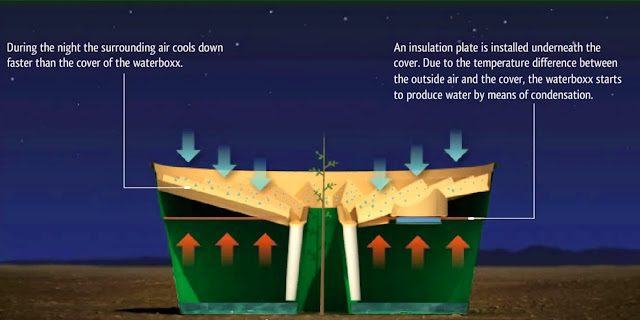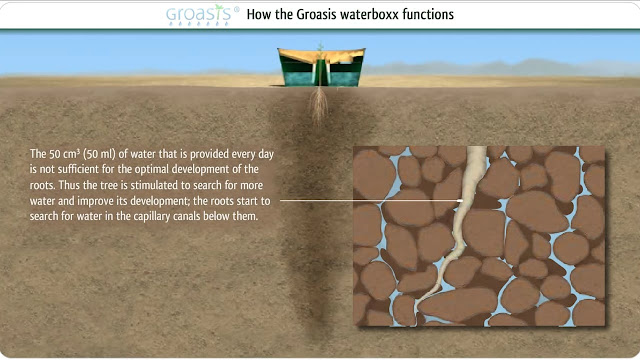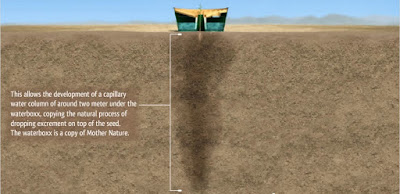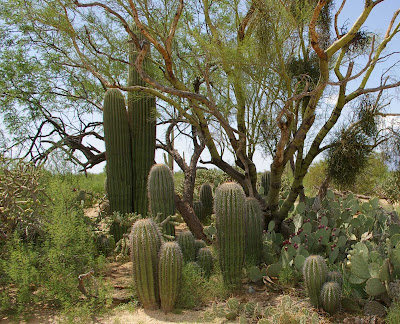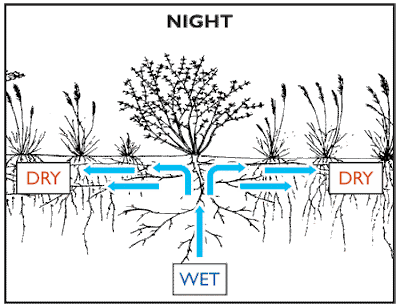Genesis 2:5-6
"No bush of the field was yet on the earth and no vegetation of the field had begun sprouting, because Jehovah God had not made it rain on the earth and there was no man to cultivate the ground. But a mist [fog, vapor] would go up from the earth, and it watered the entire surface of the ground."
For the moment before you freak out about the quoted text from Genesis, dump all the secular ideological baggage against the source referenced above and focus here for a change. I'll explain why I quoted this text above from Genesis down below at the bottom of this post. There are whole plant ecosystems around the Earth which are not necessarily hydrated by conventional storm systems we are all familiar with, but rather from a hydrological phenomena originating from fog, vapor or even a mist. I've written about some of these in the past such as Ascension Island, Canary Islands and even minerotrophic systems such as those that receive no rainfall ever like large Oasis in the Sahara of North Africa which predominantly are hydrated by means of underground springs. Yet the plants within those ecosystems do thrive and replicate themselves. Here is an update on some things I wrote previously about Ascension Island.
Climate Change and "Ascension Island" (Ideology trumps Reality)
| Photo by Meg Wilkie |
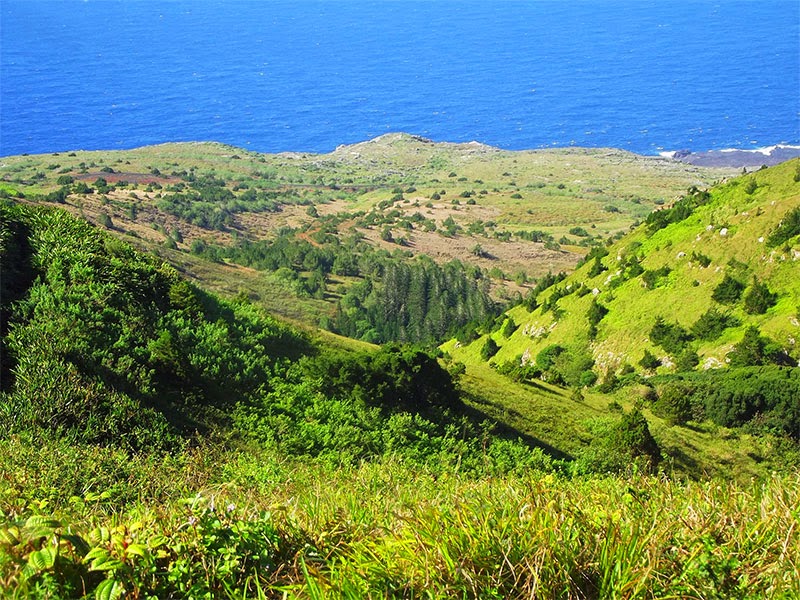 |
| image: Ascension-Island Government On a Remote Island, Lessons In How Ecosystems Function |
 |
| Lanzarote National Park of Timanfaya Canary Islands |
 |
| Image: BBC News Conservation Officer, Stedson Stroud finding a supposedly extinct Fern |
In their view, it was perfect as is and any thought of even desert plants, animals and birds thriving there was repugnant. Whatever people! It wasn't even worth giving a response. Things are not as bad on the Ascension Island as the outraged scientists want us to believe, who would rather the plant life be removed. Seriously, you have to read it to believe it. Actually, I've written Stedson and he has been busy with tough job of keeping under control one of the native plants from the Southwestern United States, Mesquite, which has spread by seed by wild feral Burros. He also has had to keep up with capturing and removing over 500 cats which were killing off the native sea birds and their young on the plains below. So clearly some things need correcting. I wrote to Stedson a message and thanked him for his hard work and to keep it up despite the vicious criticism they received. He responded with this:
"Thank you kindly for those words above, I sometimes feel let down and used by the very people I have helped and trust. But as a committed conservationist, I keep going, earlier this year I discovered a new algae and a new to science fungi in a sea vent on the South East coast of Ascension."Of course not all is lost as much of the alarmist fear mongering insisted would happen. Below is a short paragraph from another article about Ascension Island back in December 16, 2010
"Beneath the summit ridge on Green Mountain, on the lawns of a small garden, Mr Stroud nurtures indigenous plants. He discovered one fern only a couple of years ago—a species hidden for centuries. He plants the successes under a huge fig tree on the ridge. When they flourish he takes them further out into what on other islands would be the wild, but here is the artifice, returning occasionally to check up on them and take more seed. While he and his successors are here, those ferns and grasses will be safe from extinction. And a few are taking the initiative themselves. Xiphopteris ascensionis, a tiny endemic fern, had never seen a tree before the Victorian planters came. Now it lives in and on them, nestled in their moist bark, pioneering the epiphytic way of life familiar from ancient forests around the world and discovered afresh in their youngest cousin. Life, with helping hands, adapts."
(Source: BBC)Below are a couple examples of the Endemic Natives successfully mixing and taking better advantage provided by the non-native invasive plants which have provided further opportunity for them to excel and thrive more so than previously. I know many out there from the ideologically driven purist gang (Center for Biological Diversity, etc) don't want to hear or see such success stories, but to quote one of their own hallowed blind faith afirmations, "Life Finds A Way." First, take a close look at the Mist/Fog Pond near the top of Green Mountain. Near the summit of this Green Mountain is the Dew Pond which is actually kept filled with water captured from plant foliage from the Mist/Fog that moves across the landscape from the surrounding Atlantic Ocean, constructed in 1875. There are water Lilies and some tiny goldfish in the pond. I believe the pond was constructed near an area ravine which was historically given the name Dampiers Drip.
 |
| image: Arkive.org Fern (Xiphopteris ascensionensis) |
 |
| image: Arkive.org Fern (Xiphopteris ascensionensis) and Moss most likely on a Laurel tree branch |
Some Further Reading Reference on Ascension Island
On a Remote Island, Lessons In How Ecosystems Function
The Economist: "Another green world"
(2012) Team Member Stedson Stroud – Saving Ascension’s wildlife
Ascension Island - plant restoration
http://www.kew.org/press/images/Anogramma_ascensionis.html
Another interesting paper co-authored by Stedson Stroud of the Conservation Depart. of Georgetown on Ascension Island and David C Catling from the University of Washington
University of Washington, Seattle, Wash: "The Greening of Green Mountain, Ascension Island"
So where does all of this leave us now ?The subject of Climate Change is all over the Global News, but what you won't find in the Nightly News are success stories of how Nature drives and maintains climate on Ascension and Canary Islands.And when News Journals do draw attention, it's merely a token acknowledgement nature story as something of local interest and then shelved away. The actual education of John Q-Public of the interesting biological mechanisms which make the whole climate thing a success never rakes place because demonizing one's political opponents and their worldview is generally the goal. Once again, this subject should be in the main stream news. But it's not, other than the political back biting and positioning one team over another. The questions that are not being asked here are, "What are the mechanisms which make the global climate function, what creates clouds and moderates the weather, how does rainfall and other precipitation really occur and what do plants have to do with that ?" But we don't get such questions or their answers. There are plenty of other examples like Easter Island where uncontrolled deforestation hurt the population in the end. Other examples of desertification in Africa and the American southwest as the result of plant communities being obliterated for short term profit potential could be helped once again to a recovery by further research and understanding of how these mechanisms function. If vegetation removal causes less rain and mega-droughts, shouldn't replanting reverse that ?
Occult Precipitation (Oxford Reference) ??? ☂☂☂
 |
| Photograph: Miguel Sequeira |
Cloud water interception in the high altitude tree heath forest (Erica arborea L.) of Paul da Serra Massif on Madeira
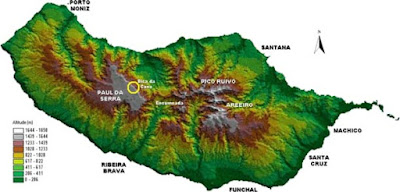 |
| Animation - Research Gate |
References for Cloud Forest Precipitation
Cloud Water Interception in the high altitude Tree Heath Forest Erica arborea L of Paul da Serra Massif Madeira Portugal
Occult Precipitation on Madeira Island
But what about all those other Myths, Fables, Storytelling historically condemned by the prevailing Scientific Orthodoxy ???Throughout the 20th century, there have been many stories or legends about natural phenomena which were written or spoken about in ancient times by various cultures and peoples who for the most part have been regarded as mere superstitions, myths, fables, etc by today's various intellectual elites. But I have always been really intrigued and curious about what real natural world phenomena they were first hand eye witness observers to and from which they could only explain things based on their limited knowledge of things like science. For example, about a month ago I watched a science documentary about the first discovery of many of the new animals originally found and documented by scientists in Australia when Europeans first colonized. There was debate over whether Duckbilled Platypus actually laid eggs or gave live birth. The Aboriginal natives had told the White Europeans that the Platypus laid eggs, but this was discounted as a fable and myth, because these peoples were illiterate, ignorant, primitive savages and what could they possibly know that a white European scientist couldn't discover and verify. Until that happened, such a thing was ridiculous. As it turned out such official verification and discovery was up to British Scientist William H. Caldwell. Click on this link and read the first short paragraph under introduction. It verifies what the BBC documentary I watched said:
"The central narrative of this paper is the 'discovery' by British scientist W H Caldwell that monotremes (platypus and echidna) lay eggs. The famous telegram 'monotremes oviparous, ovum meriblastic' (monotremes lay eggs of the same sort as reptiles), sent to the British Association for the Advancement of Science meeting in Canada in 1884, put to rest a debate about whether platypus laid eggs or had live young that had raged throughout the century. The story reveals much about the imperial shaping of scientific knowledge. Observers in Australia and Aboriginal informants, who had asserted that platypus laid eggs, had been disbelieved. 'Discovery' was reserved for Caldwell, a British scientist of impeccable scientific lineage."
(Source)
Another interesting natural phenomena which in the past hasn't receive much press or given much acknowledgement is the incredible phenomena of Mushroom or Truffle formation by mycorrhizal fungi almost not long after Lightning Storm occurrs. The Romans and Greeks both recorded such observations, but these have been condescendingly dismissed by most Scientists as myths or fables if you've tried to research the literature. The accounts have been categorized under what are a part of the Roman and Greek Mythologies. Then of course there are also the Bedouins of the Negev who call these desert truffles ‘the thunder fungus’ and so do other African peoples who search for the Kalahari Desert Truffles after lightning storms. But I've also known of this from personal observation back in the 1980s when I would go out to search for Pisolithus tinctorius mycorrhizal truffles. Certainly many would appear in Spring, but especially after the Monsoonal Thunderstorm season hit Anza California starting around the first of July. Almost two weeks after the heaviest Thunderstorms hit our area my favourite collection areas would provide a mother-lode of them. They are edible and sometimes they would still be a fresh white colour, but I wanted dried truffles for their spores for inoculation of my plant's rootsystems. So I waited a while for them to age. The main point is, while I always knew the location, I never knew the when until after Lightning Storms. Here is a previous post of mine where I providedreferences giving some legitimacy to what the Experts have labeled myths about truffle formation after lightning storms.
Snap, Crackle & Pop!, Rumor has it that the Lightning gods make the Mushrooms (truffles)Then of course there are what many would call the biblical creation myths. Okay, I get the arguments and dislike Secular Scientists & their modern day IFL members have against Christendom. Frankly, I don't care for many of their beliefs or their historical atrocious conduct either, but the newer 20th & 21st century enlightenment Free-Thought Gang hasn't exactly managed the world's affairs any better since they began asserting their own version of religious Orthodoxy's influence over the world's affairs. Pushing that baggage aside for the moment, let's go back and look at the referenced verse 6 of Genesis 2 below and read it.
This scriptural text has always intrigued me since the early 1960s when it was first read to me. Why ? Because it's odd, it's not normal, sounds crazy and out of touch with today's reality as I understood normal hydrology and climate. In other words, I've only understood rainfall coming from an actual storms off oceans, moving over land masses and dumping rain. Still, in view of how other peoples have been treated in the past by so-called intellectuals which were proven wrong, could there really be any shade of truth to this description by ancient peoples from a time period in which our natural world's climate driving mechanisms were more intact, even if this were only a mere unexplainable observation ? So I asked myself, could this original writer have also been recording information as he actually observed it back several thousand years ago ? So was this writer recording phenomena occurring as it was normal and common to him and others thousands of years ago ? Ultimately I really have no idea to be sure. But the location where these texts were written down was in the Sinai Peninsula which is right next door to where moisture is observed hydrating the various ecosystems within those western Saudi Arabia Mountains today next to the Red Sea. Once again I still have no real clue, and it was this puzzle got me interested more and more in just how plants could hydrate an entire community through a mycorrhizal fungal networks under pristine healthy vegetative conditions which would have been more common then in ancient times thousands of years before our planet with it's present 8+ billion humans who have mostly defoliated this Earth. What we can acknowledge is that the present mist or fog precipitation phenomena didn't always occur on Ascension island prior to the introduction of Trees, Shrubs and other plants. But now at present it does occur as a result of the trees and shrubs which took over and created a cloud forest. Also we know now that desertification does indeed occur when vegetation is removed from an environment. Given the fact that far less humans existed at that time period and more healthy vegetative systems were most likely in existence 1000s of years ago than today, it could be reasonable to assume such a common hydrological system was real at one time.Genesis 2:6 - Amplified Bible"But there went up a mist (fog, vapor) from the land and watered the whole surface of the ground"
Even Austrian Forester and Physicist Viktor Schauberger (1878-1958) who wrote extensively about water and often tried to describe a phenomena of upwards movement of water (soil's natural capilliary action) within healthy old growth forests by attributing such phenomena to some sort of mysterious energy, had the prevailing scientific community of critics who thought he was a crackpot. How could he possibly have ever known what we do today about old growth forests incredible ability at Hydraulic Lift and redistribution ? But he did however make observations of pure clean water springs and brooks disappearing after old growth forest trees were cut down. He attributed it to the sun having a negative effect of draining power away from the naturally occurring energized water as he called it. Today however we know far more than he did and yet he was correct that such a phenomena did indeed exist. We do know about hydraulic lift and redistribution. We do known the phenomena of a soil's capillerary action with both upwards and downward movement of water. This phenomena is further enhanced by other phenomena by deep rooted Trees & Shrubs in what is known as Hydraulic Lift & Redistribution & Hydraulic Descent. While much research into both of these has been undertaken by some researchers, the public in general is oblivious to most of this infavour of conventional science. The main problem with today's intellectual movement is that they will automatically discount such phenomena for no other reasons than they hate of the messengers. That's irresponsible, but clearly throughout time, this has been the historical precedent. How many important discoveries have been stifled because of the condescending arrogance by the ruling elite Scientific Orthodoxy which controls most thought in our world today ? At least for the people who know me and what I am talking about, this phenomena and other intriguing complex networked functions which move and provide moisture to sustain ecosystems, this gives hope and promise that based on many of these facts, that our earth can be biologically repaired and made a more sustainable place in which to reside. The only thing that stands in the way is proper leadership around the globe. As time pants on to the end, count on this leadership getting weirder and weirder. This doesn't let the whole of Christendom off the hook either for their refusal to denial of global climate change because they involve themselves within a certain specific segment of rightwing politics which is opposed to leftwing secularism:
Matthew 24:37-39 - A warning message of 'Climate Change' & the consequences of "Apathy" ?Still, for the moment, people can still decide what to believe and make practical application where important. Take special note of something I wrote about yesterday which can speed up the process.
Groasis Waterboxx: Desert Greening, Root Infrastructure Development, Water Savings, Teaching Kids Nature, etc, etc, etc


